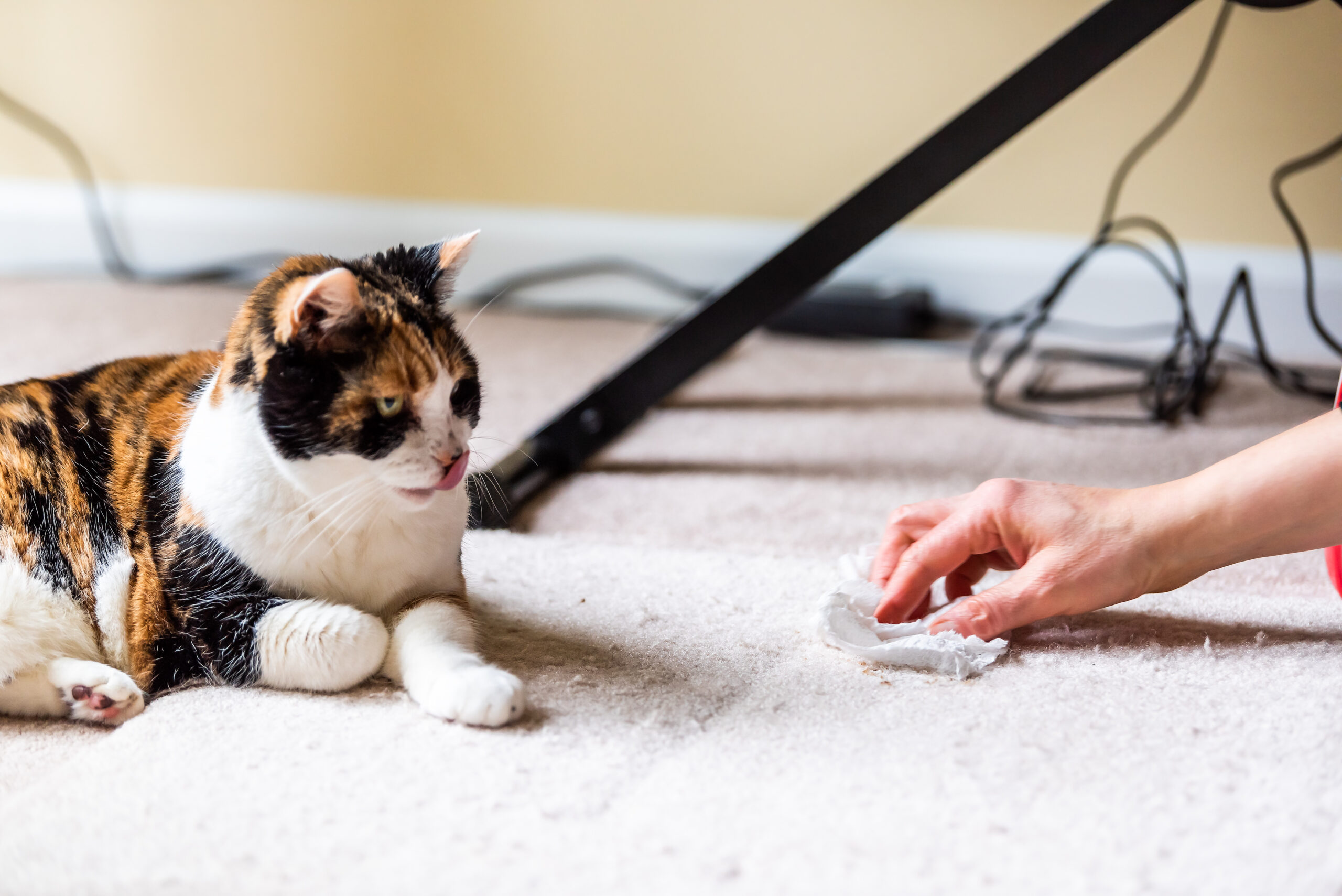How To Remove Cat Urine From Carpet

Cleaning up cat urine is a task anyone would avoid if they could. However, if you have been given the chore of cleaning up cat urine— fear not. Experience in animal urine allows us to confidently guide you in effectively removing cat urine from the carpet.
But first, let it be known: cat urine can be very dangerous for your health. You can read more to learn why cat urine threatens your well-being and when to call a professional for help. However, unless you are in a cat or animal hoarding situation, chances are you’ve got this on your own.
Just remember to wear gloves and a mask. And play some music, too, to distract yourself from the nasty task at hand.
Why Cat Pee Smells
Like most anything made of organic matter, cat urine has a decomposition process. The longer the urine has sat in the carpet, the more foul it may smell. After a while, bacteria in the cat urine begins to decompose.
That ammonia smell? The smell that feels like acid on your nose? That smell is the bacteria in cat urine. When that smell becomes pungent, that means the cat urine has begun its decomposing process. While the cat pee reaches the second and third stages of its decomposition, it releases mercaptans — the crucial compound in what gives skunks their skunk-y smell.
Male cats that have not been neutered will emit an extra smelly urine because they have hormones in their pee. The hormones add an extra layer of smell as the urine settles into the carpet and begins to grow stale.
The longer that cat pee sits, the worse it will smell. So if you think the smell is already terrible, you better get to work before the stench becomes unbearable.
When Cat Pee is Dangerous
Cat urine has a ton of ammonia in it, and ammonia is a toxic gas that can really make things messy in your brain. Ammonia in cat urine is known to be the cause of headaches and bring about asthma attacks.
In some extreme cases of inhalation, feline pee can give people respiratory issues like pneumonia. People with weak immune systems (consider children, elderly people, those with immunity issues) pose a higher risk of infection from ammonia when exposed.
Unfortunately, it gets worse.
Cat urine is notorious for causing roundworms. Roundworms are nasty little parasites that live inside of cat poop. Why are we mentioning this? Because if you are dealing with cat urine, chances are you might be picking up some cat poop, too. Roundworms like to burrow in cat poop and can move on to burrowing inside of humans, too. Roundworms can lead to diarrhea, weight loss, throwing up, and much more.
If you are immuno-compromised and are exposed to excess cat urine and animal feces, hire professional help. The risk to your health is not worth it.
Now that we have probably grossed you out further than you already were, let’s get into the removal.
Step 1
If the cat urine in the carpet is fresh, blot the mess with a towel. Make sure to get as much of the urine out of the carpet as possible by soaking up the urine with said towel. Apply pressure to the towel so that you can soak up urine that has settled on the backing of the carpet.
Step 2
Rinse the area. Be meticulous with your rinsing. Make sure to use a fresh rag while you are rinsing out the area so that you are not circulating urine from the rag back into the carpet.
Tip: don’t use a steam cleaner, because heat may set the stain.
Step 3
Purchase an enzyme cleaner to douse the area with. If the enzyme cleaner you have selected comes in a spray bottle, open the spray bottle up and pour directly into the urine. You want to make sure you soak the area with enzyme cleaner— not just dust the top of the carpet with spray.
Don’t be afraid of using too much product. Remember, cat urine is potent and strong. You will need to bring out the big guns for this one!
Step 4
After you have doused the area with enzyme cleaner, let the cleaner sit for a while. Consider about 10-20 minutes. When the cleaner has sat for the appropriate time period, soak the enzyme cleaner up with a fresh cloth.
If you find that the area still smells after you’ve cleaned up the urine, repeat this process. You may have to repeat this process a few times for older stains that have decomposed for a long time.
Alternatives
If you would prefer to use an all-natural solution rather than a store bought enzyme cleaner, you can use vinegar and water. Use equal parts vinegar and water in a bucket and use the same steps.
